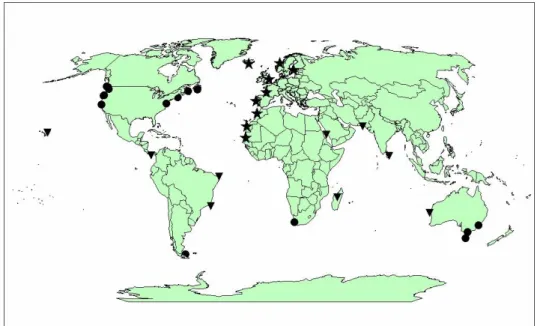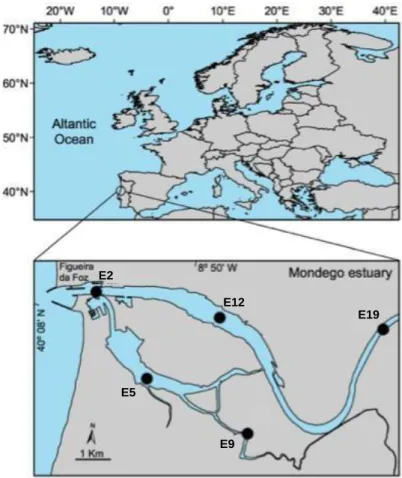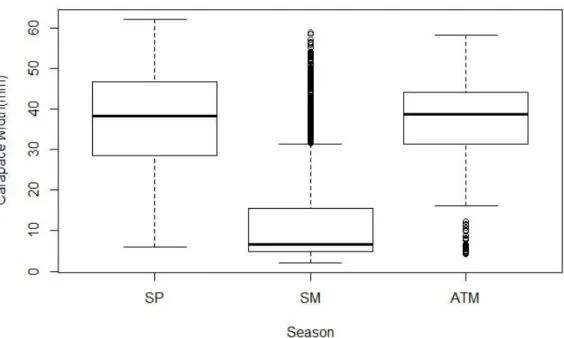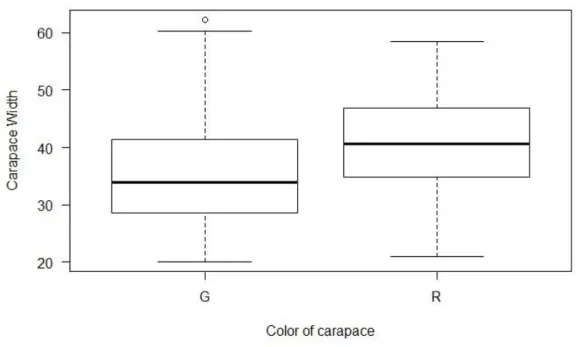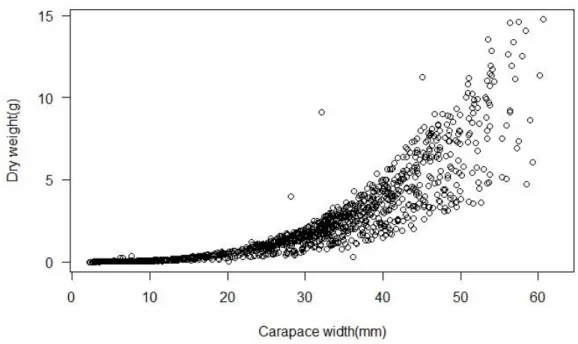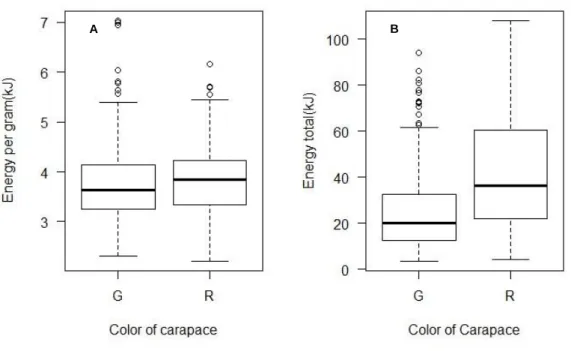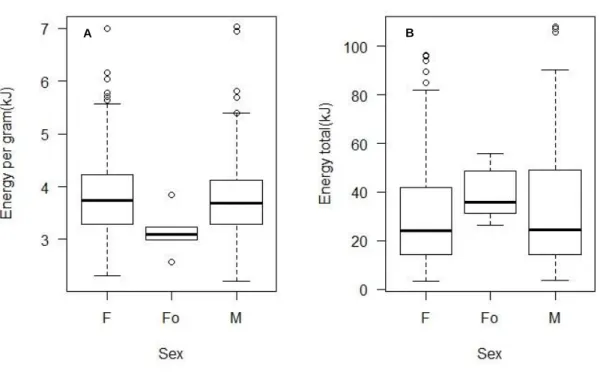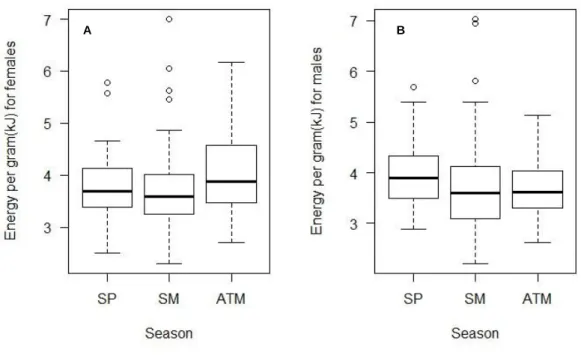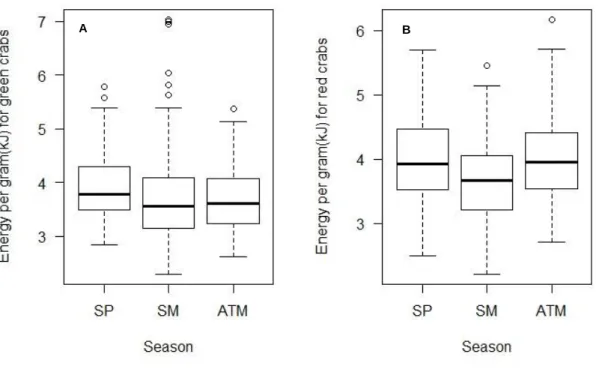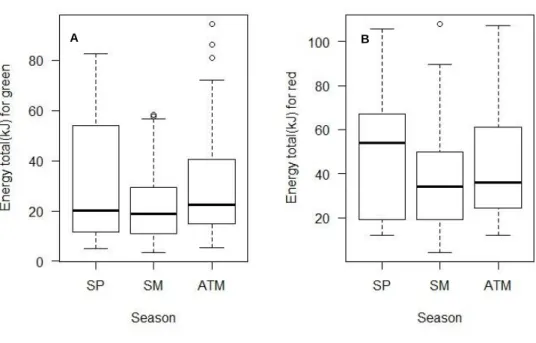Energy content of shore
crab Carcinus maenas
from a temperate
estuary in Portugal
Kelly de Oliveira Duro
Recursos Biológicos Aquáticos
Departamento de Biologia 2016
Orientador
Joana Campos, Investigadora, CIIMAR
Coorientador
Todas as correções determinadas pelo júri, e só essas, foramefetuadas. O Presidente do Júri,
FCUP i Energy content of shore crab Carcinus maenas from a temperate estuary in Portugal
Acknowledgments
From all people, I want to specially thank my mom for making this possible for me; for making it easier for me to carry my studies and for all the strength that she has been giving me all this years. I also, want to thank my supervisor Joana Campos for all the help she gave me and for believing in this project when I started doubting it; my cosupervisor Henk Van der Veer for allowing me to do half of this project at NIOZ; to my good and oldest friend Joana, for always helping me when I needed it and for being there always. Finally, a big thank you to all people that I met throughout this year, people who taught me to not put too much pressure on myself and enjoy the little things.
Agradecimentos
De todas as pessoas, quero agradecer especialmente, à minha mãe por tornar isto possível para mim, por me ter facilitado a continuação dos estudos e por toda a força que me tem nada ao longo destes anos. Também quero agradecer à minha orientadora Joana Campos for toda a ajuda que me dou e por ter acreditado neste projecto quando eu começava a não acreditar; ao meu co-orientador Henk Van der Veer por me ter permitido realizar metade do meu projeto no NIOZ; à minha grande, e mais antiga amiga, Joana por me ter ajudado quando precisava e por estar presente sempre. Finalmente, muito obrigada a todas as pessoas que conheci ao longo deste ano, pessoas que me ensinaram a não colocar demasiada pressão em mim e a apreciar as pequenas coisas.
Abstract
The crab, Carcinus maenas (Linnaeus, 1758), is one of the most studied brachyuran species because of invading a wide geographic area facilitated by its broad tolerance to different temperature and salinity, long larval phase which enables dispersal and the capacity to survive long periods of starvation. Energy density is used to measure an animal growth and food consumption; it is a result of genetic constitution, nutritional condition and life history, and it varie with species, seasons and environment. Living organisms need energy for growth, reproduction and maintenance. In this work a total of 2746 crabs from Mondego estuary were colected from April of 2015 to November of 2015 and analyzed for biometry: 480 females, 6 females baring eggs, 380 males, 1872 juveniles. From these, 376 adult crabs were analyzed for energy content, although only animals with a carapace width superior than 20mm were used for calories assessment. Carapace width (CW) ranged from 2.17- 62.20mm, with an average of 36.64mm for females, 36.60mm for males and 6.69mm for juveniles Dry weight (DW) varied between 0.0006- 14.7500g (an average of 3.1924g for females,
3.3877g for males and 0.0440g for juveniles) and the wet weight (WW) between
0.0013-55.7100g (an average of 11.1295g for females, 11.8015g for males and 0.1203g for juveniles). On average Carcinus maenas at Mondego estuary presented a total energy content of 32.170kJ, with a maximum of 107.900kJ and a minimum of 2.216kJ. For females the average was 30.715kJ and 33.785kJ for males; yet those differences were not statistically significant. The present study revealed that there is a spatial and temporal change in energy content of C.maenas. Energy content does not depend on color or sex but energy content depends on the life cycle. Furthermore, the changes in energy along the estuary reinforce the importance of food availability and habitat structure for C. maenas.
FCUP iii Energy content of shore crab Carcinus maenas from a temperate estuary in Portugal
Resumo
O caranguejo, Carcinus maenas (Linnaeus, 1758), é uma das espécies de Brachyura mais bem estudados devido à invasão de uma ampla área a nível mundial facilitada pela sua tolerância a diferentes temperaturas e salinidades, fase larvar prolongada que possibilita a sua dispersão e a capacidade de sobreviver longos períodos sem alimentação. A densidade energética é usada como medida do crescimento de um animal e consumo de alimento; resulta da constituição genética, condição nutritiva e história de vida para além disso, varia com a espécie, época do ano e ambiente. Organismos vivos necessitam de energia para crescimento, reprodução e manutenção. Neste estudo, foram analisados para biometria um total de 2746 caranguejos capturados no estuário do Mondego entre Abril de 2015 e Novembro de 2015: 480 fêmeas, 6 fêmeas com ovos, 380 machos, 1872 juvenis. Desses, 376 caraguejos adultos foram analisados para o conteúdo energético, contudo apenas animais com largura de carapaça superior a 20mm foram usadas para calorias. A largura da carapaça (CW) variou de 2.17- 62.20mm, com uma média de 36.64mm para fêmeas, 36.60mm para machos e 6.69mm para juvenis. O peso seco dos caranguejos (DW) variou entre 0.0006-14.7500g (um média de 3.1924g para fêmeas, 3.3877g para macho e 0.0440g para juvenis) e o peso húmido (WW) entre 0.0013-55.7100g (uma média de 11.1295g para fêmeas, 11.8015g para machos e 0.1203g para juvenis). Em média, Carcinus
maenas no estuário do Mondego apresentou uma energia total de 32.170 kJ, com um
máximo de 107.900kJ e mínimo de 2.216kJ. Para as fêmeas a média foi de 30.715kJ e para os machos de 33.785kJ, no entanto estas diferenças não foram estatisticamente significativas. O presente estudo revelou que existe variabilidade temporal e espacial do conteúdo energético de Carcinus maenas. O conteúdo energético não depende do sexo ou da cor, no entanto, o conteúdo energético depende da fase do ciclo de vida. Para além disso, a variabilidade energética ao longo do estuário reinforçam a importância da disponibilidade de alimento e a estruturação do habitat para C. maenas.
Keywords
Carcinus maenas, energy, sex, color, season, sampling station, Mondego estuary, salinity,
temperature, climate change, Fulton’ condition factor
FCUP v Energy content of shore crab Carcinus maenas from a temperate estuary in Portugal
Content
Acknowledgments ... i Agradecimentos ... i Abstract ... ii Resumo ... iii Keywords... ivList of figures ... vii
List of abbreviations... viii
1. Introduction... 2 1.1 Background ... 2 1.2. Physiological tolerance ... 4 1.3. Energy density ... 5 1.4. Parasites ... 6 1.5. Climate change ... 7 2. Objectives ... 8
3. Material and methods ... 9
3.1. Sampling site ... 9 3.2. Sampling program ... 9 3.3. Biometry ... 9 3.4. Calorimetry ... 10 3.5. Data treatment ... 10 3.6. Statistical Analysis ... 11 4. Results ... 12 4.1. Biometry ... 12
4.2. Spatial and temporal distribution ... 15
4.4. Fulton’s condition factor (K) ... 22
4.5. Parasites ... 25
5. Discussion ... 26
5.1. Distribution of Carcinus maenas in the estuary ... 26
5.2. Energy content ... 26
5.3 Fulton’s condition factor (K) ... 27
5.4. Parasites ... 28 6. Conclusion... 29 7. References ... 30
FCUP vii Energy content of shore crab Carcinus maenas from a temperate estuary in Portugal
List of figures
Fig. 1. Worldwide distribution of Carcinus maenas Fig. 2. The Mondego estuary
Fig. 3. Carapace width of C.maenas along sampling stations Fig. 4. Seasonal variation of carapace width of C.maenas Fig. 5. Variation of carapace width with sex of C.maenas
Fig. 6. Variation of carapace width with color morphotype of C.maenas Fig. 7. Relationship between carapace width and dry weight of C.maenas
Fig. 8. A: Energy per gram of dry weight among color and B: total energy among morphotype of C. maenas
Fig. 9. A: Energy per gram of dry weight for sex; B: Total energy for sex of C.maenas Fig. 10. A: Seasonal variation of total energy for females; B Seasonal variation of total energy for males
Fig. 11. A Seasonal variation of energy per gram of dry weight for; B. Seasonal variation of energy per gram of dry weight for males
Fig. 12. A. Seasonal variation of energy per gram of dry weight for green; B. Seasonal variation of energy per gram of dry weight for red crabs
Fig. 13. A. Seasonal variation of total energy for green; B. Seasonal variation of total energy for red crabs
Fig. 14. A. Spatial variation of energy per gram of dry weight; B. Spatial variation of total energy of dry weight
Fig. 15. A. Spatial variation of energy per gram of dry weight for green crabs; B. Spatial variation of energy per gram of dry weight for red crabs
Fig. 16. A. Spatial variations of total energy of dry weight for green crabs; B. Spatial variations of total energy of dry weight for red crabs
Fig. 17. Relationship between dry weight and total energy of C.maenas. Fig. 18. Fulton's condition factor for the two morphotypes of C.maenas (K) Fig. 19. Fulton's condition factor among sex of C.maenas (K)
Fig. 20. Seasonal variation of Fulton's condition factor (K) Fig. 21. Spatial variation of Fulton's condition factor (K)
List of abbreviations
ATM: autumn CW: carapace width DW: dry weight F: femaleFo: female with eggs G: green
J: juvenile
K: Fulton’s condition factor M: male R: red SM: summer SP: spring
1. Introduction
1.1 Background
1.1.1. Carcinus maenas
The green or shore crab, Carcinus maenas (Linnaeus, 1758), is one of the most studied brachyuran species because of its wide geographic invasion facilitated by its tolerance to different temperature and salinity, long larval phase which enables dispersal and the capacity to survive long periods of starvation. It is native to Europe and Northern African (Baltic Sea in the east; Iceland and Norway in the west and north; Morocco and Mauritania in the south) and has been introduced (mainly anthropogenic dispersal, but also by natural dispersal due to environmental incidents such as El Niño) in both coast of North America, parts of South America and South Africa, Australia and Tasmania (figure 1) (Roman and Palumbi 2004; Yamada et al. 2005; Edgell and Hollander 2011; Leignel et al. 2014) This widespread species is an opportunistic predator, feeding on a variety of organisms; most common prey are mussels, shrimp, algae, other crustacean, fish, polychaetes, and cannibalism is also common. The life cycle of this species is influenced by seasonal variations and spatial distributions (Baeta et al. 2006; Chaves et al. 2010; Leignel et al. 2014).
Figure 1.Worldwide distribution of Carcinus maenas (stars= native range; circles= introduced establishment with successful establishment and triangles= failed introductions). (Source: Klassen and Locke 2007)
The green crab can be identified by five teeth on the anterolateral margin of the carapace, a slightly prominent front of the carapace with a rounded rostral area, orbit with dorsal
FCUP 3 Energy content of shore crab Carcinus maenas from a temperate estuary in Portugal
fissure and fifth leg with a wider unspatulated dactyl. It can grow to 6 cm length and 9 cm width, having a broader body than long and it can live up to seven years. These organisms present sexual dimorphism, in which the length, convexity, width of the carapace is different between both sexes, but it is also evident the dimorphism in the abdomen, in which females have a broader and rounder abdomen, as a strategy to facilitate carrying the eggs, and the males have a triangle shaped abdomen with three to five fused somites (Klassen and Locke 2007; Leignel et al. 2014).
The females produce eggs (around 185,000) once or twice a year (Klassen and Locke, 2007) and males can copulate throughout the year, since they present viable spermatozoa all year round (Lyon et al. 2012). Hatching occurs from May to July in Europe (Lee et al. 2015). The larval pelagic phase (50-82 days) is comprised of four zoeal stages with vertical migrations and on a final megalopae stage, which settles into benthic habitats where it will metamorphose to the first stage juvenile crab. The larval development duration depends on temperature, food and salinity, so the timing of each phase of the life cycle varies geographically. Furthermore, the larvae phases are more vulnerable to environmental changes than the adults (Leignel et al. 2014; DiBacco and Therriault, 2015; Klassen and Locke, 2007)
There are two color morphotypes, green and red, which are related with post-moult and a prolonged period of inter-moult, respectively. Studies show that the red morphotype is less adapted to environmental stress, such as low salinity and temperature, than the green morphotype, albeit the red coloration offers better success in mating, since red males are stronger than the green ones, which offers them an advantage during feeding, not only because of the claw size but also because of their closer muscle (Lee and Vespoli, 2015). In other words, the green morphotype is growth oriented and the red morphotype represents a period of reproductive effort. Females bearing eggs do not moult, although they previously have to moult in order to mate (McGaw et al. 1999; Lee et al. 2003; Baeta et al. 2005; Leignel et al. 2014, Lee and Vespoli, 2015).
The shore crab can be found in intertidal and subtidal zones having colonized a broad range of hard and soft habitats - salt marshes, estuary, woody debris, rocky substrate and seagrass (Leignel et al. 2014; Klassen and Locke, 2007). Settlement of crabs occurs during the megalopae phase, in which they select the suitable habitat to metamorphose. Moksnes (2002) concluded that the megalopae settled in structured habitats, like mussel beds, shell debris, eelgrass and filamentous algae patches in contrast to open sand without shelter, where the predation rates are higher. Abundance of megalopae and first instar crab averaged 114-232 crabs/m² in structured habitats and 4 crabs/m² on open sand. Juveniles start to concentrate more on mussel beds and on open sand instead of eelgrass and algae patches. According to Klassen and Locke (2007) on native ranges,
where populations have been established for a long time, densities of adults C. maenas are on average 5 crabs/m² or lower.
For the reasons discussed above and also due to C. maenas sensitivity to contamination, this species uphold a high interest in ecotoxicological evaluation, functioning as an environmental indicator of habitats in biomonitoring studies (Klassen and Locke 2007; Rodrigues et al. 2012). Moreover, the importance of C. maenas goes beyond the factors mentioned previously, since this species holds economic impacts because of its responsibility in shifts in invaded ecosystems related to their diet, influencing abundance and distribution of other species (Klassen and Locke, 2007).
1.2. Physiological tolerance
Green crabs, as well as other marine invertebrates, are poikilotherm, which means that their physiological condition and distribution are highly dependent on seasonal and daily environmental variations (Kelley et al. 2011). This species presents a great tolerance to broad ranges of temperature, salinity, hipoxia and a high resistance to starvation. This wide spectrum is mainly due to their high plasticity that allows them to undergo biological processes to acclimate to changing environments (Edgell and Hollander 2011; Tepolt and Somero 2014).
1.2.1. Temperature
Temperature is responsible for shifting animal’s fitness because of its effect on biological processes. Matozzo et al. (2011) suggest that Carcinus aestuarii under changing temperature, are able to modulate their cellular and biochemical parameters in order to adapt to environmental stress.
The shore crab is eurythermic, able to survive temperatures from 0º to 35ºC, though preferred temperatures are between 3ºC and 26ºC (Leignel et al. 2014). The early stages are more sensitive to temperature variation. For these life stages, temperature plays an important role not only on the duration of their development, with lower temperatures increasing the mean duration of larval development, but also influencing their survival rate (Klassen and Locke 2007). Zoeal development and survival tend to be more efficient between 12.5 to 20ºC (DiBacco and Therriault 2015).
Kelley et al. (2011) studied two populations of C. maenas in an invaded region of North America, comparing populations from north and south. The results suggest that the population from the North, from colder waters, had higher carapace width and those
FCUP 5 Energy content of shore crab Carcinus maenas from a temperate estuary in Portugal
crabs were also more thermally sensitive than crabs from warmer waters. Body size is important since it influences physiological performance, fecundity, longevity and macroecological patterns (Kelley et al. 2015).
Temperature also influences feeding behavior of poikilotherms. During winter, when the water is colder, green crabs tend to feed less (Leignel et al. 2014; Klassen and Locke 2007). Similarly, Jimenez and Bennett (2007) suggest that spring temperatures in the northwest of Florida increased feeding and digestion rates allowing Uca pugilator to replenish winter storage.
1.2.2. Salinity
The development of C. maenas is directly linked to salinity. The shore crab is a euryhaline osmoregulator that inhabit a broad range of salinity (4 to 52‰ during migration from estuaries to marine zones), but prefers salinities between 10-30‰. Similarly to temperature tolerance, C. maenas larvae are less lenient to salinity changes than juveniles, which in turn are more tolerant than adults (Leignel et al. 2014). Salinity also influences larval development in association with temperature (Klassen and Locke 2007). The rate of oxygen consumption in zoeal larvae tends to decrease with low salinities, although the reason for this to happen is not yet known. It might be due to decrease in food uptake, debilitated conversion efficiency or both. This proposes a low or inexistent ability of osmoregulatory capacity in larvae stages of the shore crab (Anger et al. 1998). Low salinities are also responsible for an increase in locomotor activity as a way to escape from adverse conditions, which lead to an increase in energy expenditure, decrease in food consumption and energy absorption; consequently having a lower scope for growth (McGaw et al. 1999; Rodrigues et al. 2012).
1.3. Energy density
Energy density is used to measure an animal growth and food consumption; it is a result of genetic constitution, nutritive condition and life history, and it varies with species, seasons and environment (Goley 1961). Living organisms need energy for growth, reproduction and maintenance. Each species has a different flow of energy. In this case, on an average 44% of the food consumed by C. maenas is digested, of which 73% is spent for tissue growth (including 9% lost with exuviae) and 25% for energy metabolism (Breteler 1975).
Energy expenditure and energy storage depend on seasonal changes of food availability and temperature. Juveniles of the freshwater fish - Leuciscus pyrenaicus present an
energy cycle with higher values of condition, nutrition and somatic energy during autumn, while in mature chubs the highest values of condition and nutrition are observed in spring and the somatic tissues had a peak of energy content before the summer spawning effort. In other words, the strategy to allocate energy for this species is characterized by a seasonal convergence of somatic storage and gonad development throughout the year in connection with the seasonal pulses of productivity of the ecosystem (Encina and Granado-Lorencio 1997). Dubreuil and Petitgas (2009) and Romero et al. (2006) obtained similar results for the marine fishes Engraulis encrasicolus and Munida
subrugosa, respectively. The mud crab Rhithropanopeus harrisii spp. tridentatus also
demonstrate energy fluctuations with seasonal variation, showing higher energetic content prior the reproductive season (Wiszniewska et al. 1998).
Temperature influences energy demands of animals. When temperature decreases the metabolic rate of ectotherms also decreases (Speakman 2005). Bartolini et al. (2013) studied the effects of a changing environment due to climate change, on Carcinus
aestuarii and its influence on adults, eggs and larvae. The study concluded that after an
acute heat shock or a severe hostile condition the oxygen consumption rate increased and there was an energy loss during the blastula and gastrula stage. For fishes, different latitudes influence energy reserves, with high latitudes populations adapting for higher rates of energy storage, in order to be more apt to survive more severe winter conditions (Schultz and Conover 1997).
Crustaceans alternate their feeding behavior between feeding and fasting periods throughout their development; for example, prior to moulting season feeding declines, during moulting feeding stops, restarting feeding actively after moult. Feeding behavior depends on the life cycle, for instance decapod embryos rely on the catabolism of yolk reserves that originates from maternal investment during organogenesis (Sánchez-Paz et al. 2006).
1.4. Parasites
Another factor that can affect the shore crab fitness in their native range is the presence of parasites, such as Sacculina carcini, the most studied rhizocephalan barnacle. It presents an extensive system of rootlet (interna) that penetrates the haemocoele of the host, most likely during moult; this rootlet penetrates the digestive system of the host utilizing its metabolites. During maturation, an egg sac (termed externa) is formed externally and it is projected from the abdomen. This parasite also alters haemocyte counts and tissue structure in shore crabs (Powell and Rowley 2008). A study by Larsen
FCUP 7 Energy content of shore crab Carcinus maenas from a temperate estuary in Portugal
et al. (2013) suggests that S. carcini inhibits the crab’s moult, increases mortality’ rate and affects feeding behavior due to smaller claws in infected C. maenas.
Females of the shore crab change their behavior when infected with the parasite behaving as they were carrying eggs of their own. Males become feminized: they change their behavior like female carrying eggs and also change their physical traits, turning broader their abdomen so they can optimize the externa transport (Costa et al. 2013). The probability to find parasitized crabs increases with decreasing temperatures, this might be explained by higher mortalities of the parasite in warmer temperatures (Costa et al. 2013). There is a great spatial and temporal variation on infection prevalence in
Carcinus maenas population, normally reaching 20% but it is possible to reach 40-90%
(Larsen et al. 2013).
1.5. Climate change
According with the International Panel on Climate Change (2014) climate change has already made damages to the ocean; including ocean acidification corresponding to a 26% increase in acidity, oxygen concentration have decreased in coastal waters and in the open ocean thermocline in many regions, ocean warming and rise of sea level by 0.19mm, mainly due to human actions. Changes in abundance of freshwater and marine species; species interactions and migratory patterns have already been reported. Extinction of some species has been observed due to climate change. If the current trend continues the risks to ecosystems services, animals and humans is under threat. Therefore, it is fundamental to understand more about the impacts of climate change on ecosystems and biodiversity to mitigate the effects.
2. Objectives
The present study aims to clarify the energy investment of the shore crab Carcinus
maenas from a temperate estuary. In particular, the objectives of this project are:
- To evaluate the energy content of crabs from Mondego estuary during a large time period of up to one year;
- To determine the energetic investment on reproduction;
- To evaluate the impact of Sacculina carcini parasitism in the energy content of crabs; The a priori expectation would be that the populations of C. maenas would have more energy in autumn, as storage in order to face winter, since it is suggested that during this season animals can feed less as a consequence of lower food availability.
FCUP 9 Energy content of shore crab Carcinus maenas from a temperate estuary in Portugal
3. Material and methods
3.1. Sampling site
The Mondego estuary (figure 2) is a relatively small (8.6km²), warm-temperate, polyhaline intertidal system located on the Atlantic coast of Portugal. It is divided in two arms in the terminal part (7km from the shore): North arm and South arm. The North arm is deeper at high tide with 5-10m depth at high tide and has a tidal range of 2-3m. The South arm is characterized by 2-4m depth at high tide, a tidal range of 1-3m and intertidal mudflats that correspond to almost 75% of the area, which are exposed at low tide (Nyitrai et al. 2013).
3.2. Sampling program
Sampling occured every month between April of 2015 and November of 2015, except for June and October.
A 1-2m beam trawl with a tickler chain and 5mm mesh size in the cod end was dragged at a constant speed. Three replicates were taken at each site, which were selected along a salinity gradient within each estuary. In addition, a multiparametric probe was used to record salinity, water temperature, pH, oxygen concentration and chlorophyll concentration at each sampling site and in each campaign.
The samples were stored in cooling boxes, and taken to the lab where they were frozen until they were analyzed.
3.3. Biometry
The samples were defrosted for 2h/3h prior the biometric analyses. All crabs were blotter dried with paper to remove the excess of water on the surface, and then weighted to the nearest 0.0001g (wet weight, WW); the carapace width (CW) was measured to the nearest 0.01mm using a calliper rule. Individuals smaller than 20mm were considered juveniles since sex and color for those were not possible to determine at first sight. Sex, color (determined visually: crabs with a green or yellow ventral surface were considered green and crabs ventrally red or orange were considered red, the few individuals with white or brown ventral surfaces were discarded) presence of Sacculina
were recorded. Eggs were removed and weighted and a subsample was taken for counting. Individuals with S. carcini externae were weighted also without the parasite; only the external part was removed from the host, weight and identified because the internal part is not possible to detach.
3.4. Calorimetry
Energy content of whole body was determined using an IKA C2000 basic calorimeter. Samples, including individual crabs, eggs and parasites (the last two separated from the female and host, respectively) were dried at 60ºC during 10 days, in order to obtain the constant dried weight (DW, to the nearest 0.0001g); For every sampling station of every month 3 females of each color, 3 ovigerous females and 3 females with parasites of each size class (20-30; 30-40; 40-50; 50-60; >60mm) were selected for calorimetric analysis and the same procedure was followed for males. The selected crabs were homogenized with a coffee grinder and the powdered samples were pressed in a mortar to form pellets, subsequently taken to the calorimeter where the subsamples combustion occurred and the energetic value was determined. In total, 376 adult crabs were analized individually for energy content.
3.5. Data treatment
The morphological Fulton condition factor (K) was determined following:
(1) K= 1000*(WW/CW3) – WW in mg and CW in mm
Since crabs have a shell made of calcium carbonate it is necessary to do a correction for the mineral after the calorimetric analyses, in order to avoid erroneous estimates. For that, ash retrieved after combustion in calorimetric bomb was weighted (to the nearest 0.0001g) and reburned in a muffle at 900ºC during 2h.
The reaction of calcium in the calorimeter is an endothermic reaction, i.e. absorbs heat, so it must be counted as a negative part for the correction equation. The factor to correct for the percentage of calcium is:
(2) Caloric value after corrected value = (Calorimeter value * 100/ % AFDW) – 1.4* %CaCO3 (cal.g-1 DW). (Goley, 1961)
FCUP 11 Energy content of shore crab Carcinus maenas from a temperate estuary in Portugal
whereby 1.4 cal.g-1 is the caloric value of carbonate calcium in calorimetric reactions.
Finally, caloric values will be converted to kilojoules (kJ).
3.6. Statistical Analysis
The data retrieved did not follow the normality assumption of ANOVA and hence nonparametric statistic tests were performed, namely the Kruskal-Wallis and the Mann- Whitney pairwise test. Comparisons of energy content, Fulton’s condition index and water content were made using the following factors: colour (two levels: green and red), sex (three levels: males, females without and females with eggs), length classes (20-30; 30-40; 40-50; 50-60; >60 mm) time (three levels: spring, autumn and summer) and sampling station (E2, E5, E9, E12 and E19). All tests were run in R.
Figure 2.The Mondego estuary: location of the 5 sampling stations (Mouth (E2), North arm (E12 and E19), South arm (E5) and Pranto (E9). (Source: Nyitrai et al., 2013)
E2
E12
E19
E5
4. Results
4.1. Biometry
In total, 2746 crabs were analyzed for biometry: 480 females, 6 ovigerous females, 380 males, 1872 juveniles. From these, 376 adult crabs were analyzed for energy content. Carapace width (CW) ranged from 2.17- 62.20mm, with an average of 36.64mm for females, 36.60mm for males and 6.69mm for juveniles. Dry weight (DW) varied between 0.0006- 14.7500g (an average of 3.1924g for females, 3.3877 for males and 0.0440g for juveniles) and the wet weight (WW) between 0.0013-55.7100g (an average of 11.1295g for females, 11.8015g for males and 0.1203g for juveniles).
Green crabs were more abundant than red ones, although the red crabs presented significantly higher values of carapace width with an average of 40.93mm while green crabs had an average of 35.50mm, wet weight (average for red crabs of 15.8566g and green crabs of 10.1943g) and dry weight (red crabs with an average of 5.3558g and green crabs with 2.5978g) (Fig.6.).
Carapace width varied along sampling station with bigger individuals caught in the north arm (E12 and E19), the differences were significant between E12 and the other sites as well as E19 with the other sites although there were no significant differences between one another. The smaller individuals were caught in Pranto river (E9), which was statistically significant among the other values (Fig.3.)
Carapace width also varied with season, with significant lowest values being in summer but no significant differences were registered for autumn and spring (Fig.4.).
Carapace width also significantly differed with sex, in which, the Mann-Whitney test revealed significant higher values of carapace width for females with eggs. No statistical differences were found between males and females crabs (Fig.5.).
Dry weight and carapace width, did not varied linearly. The shore crab maintained its dry weight almost constant until 20.00mm of carapace width is reached, after that an increase in dry weight with increasing carapace width is registered (Fig.7).
FCUP 13 Energy content of shore crab Carcinus maenas from a temperate estuary in Portugal
Figure 3.Carapace width of C.maenas along sampling stations (H = 787.81, df = 4, p-value <0.05).
Figure 4.Seasonal variation of carapace width of C.maenas (H = 564.53, df = 2, p-value <0.05). SP= spring, SM=summer, ATM= autumn
Figure 5.Variation of carapace width with sex of C.maenas (H = 6.5248, df = 2, p-value <0.05). F=female, Fo= female with eggs; M=males
Figure 6.Variation of carapace width with color morphotype of C.maenas (H = 57.178, df = 1, p-value <0.05). G= green; R=red
FCUP 15 Energy content of shore crab Carcinus maenas from a temperate estuary in Portugal
Figure 7.Relationship between carapace width and dry weight of C.maenas.
4.2. Spatial and temporal distribution
The highest catch of crabs occurred in August 2015 with 1335 animals (142 females, 122 males, 2 females with eggs, 1066 juveniles and 3 undetermined sex) and the smallest catch occurred in May 2015 with 43 crabs (13 females, 27 males and 3 juveniles). The sampling station where more crabs were captured was in Pranto River (E9) and where fewer crabs were found was the north arm at E19.
Bigger females were mainly captured in M and S2;
Females with eggs were only caught in summer, five in N1 and one in M; Juveniles were mostly caught in summer in Pranto station; and Males were slightly more abundant in M and S2.
Red and green crabs were less abundant in S1 and N2; more red crabs were sampled from M and N1 sites.
4.3. Energy content
On average Carcinus maenas at Mondego estuary presented a total energy content of 32.170kJ, with a maximum of 107.900kJ and a minimum of 2.216kJ. For females the average was 30.715kJ and 33.785kJ; yet those differences were not statistically significant.
The total energy content significantly differed with the color of the carapace with higher values for red crabs, although when the energy per gram of dry weight was analyzed, red crabs still showed higher values but there were no significant differences between colors of morphotype (Fig.8.).
For sex, the total energy content showed no significant differences; however the energy content per gram of dry weight was statistically significant for ovigerous females having lower energy content (Fig.9.).
Figure 8. A: Energy per gram of dry weight among color morphotype (H = 2.9527, df = 1, p-value >0.05) and B: total energy among morphotype of C.maenas (H = 46.203, df = 1, p-value <0.05). G=green; R=red
B A
FCUP 17 Energy content of shore crab Carcinus maenas from a temperate estuary in Portugal
Figure 9. A: Energy per gram of dry weight for sex (H = 6.9491, df = 2, p-value <0.05) and B: Total energy for sex of
C.maenas (H = 2.8429, df = 2, p-value >0.05). F= females; Fo= Females with eggs; M=males 4.3.1 Spatial and temporal variation of energy content
There is a relation between total energy content, sex and season only for female crabs with significant changes in autumn (Fig.10.). Although differences are visible in energy content throughout season for males, after Kruskal Wallis test no significant differences were registered. The same was recorded for energy per gram of dry weight, sex and season (Fig.11.).
Figure 10. A: Seasonal variation of total energy for females (H = 12.316, df = 2, p-value <0.05); B Seasonal variation of total energy for males (H = 5.7656, df = 2, p-value >0.05). SP=spring; SM= summer; ATM= autumn
Figure 11. A Seasonal variation of energy per gram of dry weight for females (H = 8.7359, df = 2, p-value <0.05); B. Seasonal variation of energy per gram of dry weight for males (H = 5.6861, df = 2, p-value >0.05). SP=spring; SM= summer; ATM= autumn
B A B A
FCUP 19 Energy content of shore crab Carcinus maenas from a temperate estuary in Portugal
For color of the carapace, total energy content did not significantly differ along seasons (Fig.13), nonetheless when energy per gram of dry weight was examined, red crabs exhibited higher values in autumn, which only was significantly different when compared with summer. Other seasons, did not present significant changes among them (Fig.12.).
Figure 12. A. Seasonal variation of energy per gram of dry weight for green crabs (H = 5.4352, df = 2, p-value >0.05); B. Seasonal variation of energy per gram of dry weight for red crabs (H = 8.5788, df = 2, p-value <0.05). SP=spring; SM= summer; ATM=autumn
Both energy per gram of dry weight and total energy of individuals presented significant differences among sampling stations (Fig.14.). In the first case, energy per gram was significantly different for N2 (north arm) and not for the others sampling stations, for total energy the differences were not as clear.
Energy content per gram of dry weight significantly differed for green crabs along the sampling stations, being the highest for N2 (E19: north arm). Though, there were differences in energy per gram of red crabs, those were not significant (Fig.15.). For total energy content, significant differences are present but those differences do not allow for understanding a pattern since the energy content is influenced by the size of the animal (Fig.16).
Figure 13. A. Seasonal variation of total energy for green crabs (H = 4.4389, df = 2, p-value >0.05); B. Seasonal variation of total energy for red crabs (H = 2.4095, df = 2, p-value >0.05). SP=spring; SM= summer; ATM= autumn
Figure 14. A. Spatial variation of energy per gram of dry weight (H= 24.596, df = 4, p-value <0.05); B. Spatial variation of total energy of dry weight (H = 39.86, df = 4, p-value <0.05).
B A
FCUP 21 Energy content of shore crab Carcinus maenas from a temperate estuary in Portugal
Figure 15. A. Spatial variation of energy per gram of dry weight for green crabs (H = 19.904, df = 4, p-value <0.05); B. Spatial variation of energy per gram of dry weight for red crabs (H = 13.856, df = 4, p-value <0.05).
Figure 16. A. Spatial variations of total energy of dry weight for green crabs (H = 32.62, df = 4, p-value <0.05); B. Spatial variations of total energy of dry weight for red crabs (H = 23.132, df = 4, p-value <0.05).
4.3.2. Energy content and dry weight
A B
c
There is a linear relationship between dry weight and energy content, with an increase on energy content when dry weight increases (Fig.17.). Dry weight per season showed significant smaller values during summer due to the quantity of juveniles caught in those months. Dry weight also changed with sex along season, with the exception of females with eggs, since all of those were caught in the same season.
Figure 17. Relationship between dry weight and the total energy of C.maenas.
4.4. Fulton’s condition factor (K)
Fulton’s condition factor varied between 0.002 to 0.28. Maximum values were 0.07 for females, 0.02 for males and 0.27 for juveniles. Results of this study show a significant difference for color morphotype, in which red crabs presented higher value of condition factor (Fig.18.).
There were significant differences between males and females, in which males presented a slightly higher value of the condition factor. No significant differences for sex (Fig.19.).
FCUP 23 Energy content of shore crab Carcinus maenas from a temperate estuary in Portugal
Visible changes between Fulton’s factor and season were noticeable, where there was a higher K value for summer, due to the abundance of juveniles caught during that period (Fig.20)
Figure 18. Fulton's condition factor for the two morphotypes of C.maenas (H -= 64.862, df = 1, p -value <0.05). G=green, R= red
Figure 19. Fulton's condition factor among sex of C.maenas (H = 6.9433, df = 2, p-value <0.05).
Figure 20. Seasonal variation of Fulton's condition factor (H = 54.236, df = 2, p-value <0.05). SP= spring; SM=summer; ATM= autumn
FCUP 25 Energy content of shore crab Carcinus maenas from a temperate estuary in Portugal
Along sampling station Fulton’s factor also changed but only for E12 station where the value was significantly lower than the others.
Figure 21. Spatial variation of Fulton's condition factor (H = 70.51, df = 4, p-value <0.05).
4.5. Parasites
Only four crabs with the externae of the parasite Sacculina carcini were captured during the study: three red females in E2 and one red male in E12 all during summer. Due to the lack of parasites there was not sufficient dry mass to pool together and run calorimetric analyses. On the other hand, these four organisms were analyzed for energy content but a line of comparison was not possible to establish, as mentioned previously, because of a lack of data.
5. Discussion
5.1. Distribution of Carcinus maenas in the estuary
The results of this study suggest, that in the Mondego estuary there is recruitment all year round, with a peak in summer, mainly in Pranto station since it offers favorable conditions to megalopae settlement and to the growth of juveniles, providing shelter and food resources for this life stage. It is known that breeding occurs also all year round but mostly during winter (Baeta et al, 2005). In this study, it is not possible to establish a conclusive and accurate argument due to the lack of data but an assumption can be made in regard to the distribution and abundance of the 6 ovigerous females, according to other studies. They were caught in summer and in downstream stations, this suggest that breeding might occur all year round and that migration of those individuals to areas of higher salinity occurs, where conditions to spawning are favorable (Baeta et al, 2005; Bessa, 2010). Baeta et al (2006) suggest that ovigerous females are likely to remain hidden as a strategy to overcome their vulnerable state and lower the chances to be preyed, being a justification for low abundance of ovigerous females during other seasons. More studies should be performed regarding this subject.
More red female crabs were sampled in comparison with red male, which is expected in estuarine sites, since females do not moult during reproductive season. The overall distribution of red crabs show an increase sampled from M and N1 sites, which can be explained by the fact that the red morphotype is a poor osmoregulator and so, migrates to places were the salinity is higher.
Fewer crabs were captured in the north arm of the estuary, only bigger and stronger ones, like the red morphotype which is predictable since that area is more dynamic and does not allow the development of a stable population.
This study also supports other studies in regard to bigger crabs being found in downstream areas, which indicates a migration when they get older to those locations.
5.2. Energy content
Both, energy per gram of dry weight and total energy changed among sampling stations and season.
Color of morphotype is not a factor in energy content, of crabs although if the total energy is taken into account red crabs will have higher energy content, but this can be justified with the fact that red individuals had significantly broader carapaces than green ones.
FCUP 27 Energy content of shore crab Carcinus maenas from a temperate estuary in Portugal
Females with eggs had lower values of energies per gram of dry weight, when compared with males and females. Ovigerous females usually have higher proportions of empty stomach which suggests that they lower their feeding activity during the reproductive season possibly to avoid predators (Baeta et al, 2006).
The overall energy content does not change significantly with season, which was not the
a priori expectation. Nevertheless, seasonal variation of energy per gram of dry weight
is significantly higher for female crabs for autumn. This, alongside with the mentioned above reinforces the idea that female, prior to wintering which coincides with the peak of reproductive season, will store more food when compared with males, in order to avoid feeding during these periods. Since, decapod embryos rely on the catabolism of yolk reserves that originates from maternal investment during organogenesis, females will have a higher reproductive effort than males, thus justifying the higher values of energy only for females.
Since the north arm does not have the optimal conditions for the establishment of a stable population of shore crabs, due to the coarse sediments and currents characteristic of the site, the fact that energy content per gram of dry weight is higher in N2, indicates that the type of food and probably lack of competition influences the individuals higher energy content.
The energy content was higher for red crabs of all size classes than for green, since the latter have recently moulted they energy storage is depleted as a consequence of a decline on feeding behavior prior to moulting and a complete stop during moulting periods (Sánchez-Paz et al, 2006). The stopping of feeding is a strategy allowing the crabs to remain hidden in order to avoid predation (Baeta et al, 2006). Red crabs are in a prolonged intermoult so they can feed actively.
5.3 Fulton’s condition factor (K)
Condition factor showed statistical differences among N1 sampling station and the others station, being the lowest value registered. In this site, more adult female crabs were captured, between 30-50mm of carapace width, since only stronger crabs can undertake the conditions of those sites as mentioned previously. Although salinity in that sampling station might justify its presence, the low value indicates a poor relationship between size and weight, furthermore these variations in the condition index might be related with food availability along sampling site or environmental stress. Fulton’s condition factor was higher during summer and in the Pranto station, this is expected since the highest catch of juveniles occurred in that season and station.
Significant differences between colors were present; red morphotype with higher values of K, although no significant changes in energy content per gram of dry weight were registered between colors morphotype.
Condition factor changed with season in a significant way between spring and summer, with higher values in summer which correlates with the higher abundance of juveniles caught in that period, since juveniles showed a significant higher value of K.
5.4. Parasites
Only four individuals with S. carcini were captured, which indicates low infection prevalence in the Mondego estuary. The fact that three of them were caught in the mouth of the estuary is in agreement with other studies in which parasitized animals were mainly caught in downstream areas where salinity values is higher since that is the preferential spawning area for ovigerous females, subsequently crabs with the parasite, which tend to alter their behavior acting like females baring eggs, will also migrate to downstream areas (Bessa, 2010; Costa et al, 2013). Since only red parasitized individuals were caught it may support other findings in which crabs with S. carcini tend to be in prolonged intermoult. That is a reason for the red morphotype being more commonly caught with parasites, since crabs can only concentrate in one of the two at a time, growth or reproduction. Studies also suggest, that parasitized crabs are caught mostly in areas with higher salinity, like the mouth of the estuary as an attempt to reduce the metabolism energy expenditure imposed by the parasite (Bessa, 2010; Costa et al, 2013).
FCUP 29 Energy content of shore crab Carcinus maenas from a temperate estuary in Portugal
6. Conclusion
The present study revealed that there is a spatial and temporal change in energy content of Carcinus maenas from the Mondego estuary. Energy content does not depend on color or sex but the life cycle and size have an important role on energy. Furthermore, these changes in energy along the estuary reinforce the importance of food availability and habitat structure for Carcinus maenas.
The condition factor, might not give a correct understanding of the animal state, since the water weight will influence the condition factor but not the energy. Ideally, for these studies K should be for dry weight instead of the wet weight.
Finally, more studies are necessary in order to assess the influence of environmental conditions on energy content and measurements of energy content for juveniles should be considered. Species rely on environmental parameters to trigger stages of their life cycle, temperature is one of them. In a changing climate, the influence of these changes in population dynamics should be taken into consideration in order to mitigate negative consequences.
7. References
Anger K, Spivak E, Luppi T (1998) Effects of reduced salinities on development and bioenergetics of early larval shore crab, Carcinus maenas. J Exp Mar Bio Ecol 220:287–304.
Baeta A, Cabral HN, Marques JC, Pardal MA (2006) Feeding ecology of the green crab,
Carcinus maenas (L., 1758) in a temperate estuary, Portugal. Crustaceana
79:1181–1193
Baeta A, Cabral HN, Neto JM, et al (2005) Biology, population dynamics and secondary production of the green crab Carcinus maenas (L.) in a temperate estuary. Estuar Coast Shelf Sci 65:43–52
Bartolini F, Barausse A, Pörtner HO, Giomi F (2013) Climate change reduces offspring fitness in littoral spawners: A study integrating organismic response and longterm time-series. Glob Chang Biol 19: 373–386
Breteler K (1975) Food consumption, growth and energy metabolism of juvenile shore crabs, Carcinus maenas. Netherlands J Sea Res 9:255-272
Chaves ML, Horta MS, Chainho P, et al (2010) New additions to the feeding ecology of
Carcinus maenas (L., 1758) in a South-western Europe estuary (Portugal). Cah
Biol Mar 51:229–238.
Costa S, Bessa F, Pardal MA (2013) The parasite Sacculina carcini Thompson, 1836 (Cirripedia, Rhizocephala) in the crab Carcinus maenas (Linnaeus, 1758) (Decapoda, Portunidae): influence of environmental conditions, colour morphotype and sex. Crustaceana 86: 34-47
Dibacco C, Therriault TW (2015) Reproductive periodicity and larval vertical migration behavior of European green crab (Carcinus maenas) in a non-native habitat. Mar Ecol Pro, 536
Dubreuil J, Petitgas P (2009) Energy density of anchovy Engraulis encrasicolus in the Bay of Biscay. J Fish Biol 74:521–534
FCUP 31 Energy content of shore crab Carcinus maenas from a temperate estuary in Portugal
Edgell TC, Hollander J (2011) The Evolutionary Ecology of European Green Crab,
Carcinus maenas, in North America.Marine Crustaceans: Distribution, Biology
and Impacts. pp 641–659
Encina L, Granado-Lorencio C (1997) Seasonal variations in condition and energy content of somatic and reproductive tissues of Chondrostoma polylepis. Folia Zoologica. pp 123–132
Goley PB, (1961) Energy of ecological materials. Ecol 42: 581–584
IPCC (2014) Climate Change 2014: Synthesis Report. Contribution of Working Groups I, II and III to the Fifth Assessment Report of the Intergovernmental Panel on Climate Change.
Jimenez AG, Bennett WA (2007) Metabolic responses of sand fiddler crabs, Uca
pugilator, in northwest Florida to seasonal temperature change. J Therm Biol
32:308–313
Kelley AL, de Rivera CE, Buckley BA (2011) Intraspecific variation in thermotolerance and morphology of the invasive European green crab, Carcinus maenas, on the west coast of North America. J Exp Mar Bio Ecol 409:70–78
Klassen G, Locke A (2007) A Biological Synopsis of the European Green Crab, Carcinus
maenas. Can Manuscr Rep Fish Aquat Sci 2818:1–82.
Larsen MH, Høeg JT, Mouritsen KN (2013) Influence of infection by Sacculina carcini (Cirripedia, Rhizocephala) on consumption rate and prey size selection in the shore crab Carcinus maenas. J Exp Mar Bio Ecol 446:209–215
Lee KT, Mcknight A, Kellogg K, Juanes F (2003) Salinity tolerance in color phases of female green crabs, Carcinus maenas (Linnaeus, 1758). Crustaceana 76:247– 253
Lee KT, Vespoli JL (2015) Tracking color change in individual Green Crabs, Carcinus
maenas (L). Northeastern Naturalist 22:413-423
Leignel V, Stillman JH, Baringou S, et al (2014) Overview on the European green crab
Carcinus spp. (Portunidae, Decapoda), one of the most famous marine invaders
Lyons LJ, O’Riordan RM, Cross TF, et al (2012) Reproductive biology of shore crab
Carcinus maenas (Decapoda, Portunidae): A macroscopic and histological view.
Invertebr Reprod Dev 56:144-156
Matozzo V, Gallo C, Marin MG (2011) Effects of temperature on cellular and biochemical parameters in the crab Carcinus aestuarii (Crustacea, Decapoda). Mar Environ Res 71:351–356
McGaw IJ, Reiber CL, Guadagnoli JA (1999) Behavioral physiology of four crab species in low salinity. Biol Bull 196:163–176
Mosknes, Per-Olav, (2002) The relative importance of habitat-specific settlement, predation and juvenile dispersal for distribution and abundance of young juvenile shore crabs Carcinus maenas L. J Exp Mar Bio Ecol 271: 41 – 73
Nyitrai D, Martinho F, Dolbeth M, et al (2013) Effects of local and large-scale climate patterns on estuarine resident fishes: The example of Pomatoschistus microps and Pomatoschistus minutus. Estuar Coast Shelf Sci 135:260–268
Powell A, Rowley AF (2008) Tissue changes in the shore crab Carcinus maenas as a result of infection by the parasitic barnacle Sacculina carcini. Dis Aquat Organ 80:75–79
Rodrigues AP, Oliveira PC, Guilhermino L, Guimarães L (2012) Effects of salinity stress on neurotransmission, energy metabolism, and anti-oxidant biomarkers of
Carcinus maenas from two estuaries of the NW Iberian Peninsula. Mar Biol
159:2061–2074
Roman J, Palumbi SR (2004) A global invader at home: Population structure of the green crab, Carcinus maenas, in Europe. Mol Ecol 13:2891–2898
Romero MC, Lovrich G a., Tapella F (2006) Seasonal Changes in Dry Mass and Energetic Content of Munida Subrugosa (Crustacea: Decapoda) in the Beagle Channel, Argentina. J Shellfish Res 25:101–106
Sánchez-Paz A, García-Carreño F, Muhlia-Almazán A, et al (2006) Usage of energy reserves in crustaceans during starvation: Status and future directions. Insect Biochem Mol Biol 36:241–249
FCUP 33 Energy content of shore crab Carcinus maenas from a temperate estuary in Portugal
Schultz ET, Conover DO (1997) Latitudinal differences in somatic energy storage: Adaptive responses to seasonality in an estuarine fish (Atherinidae: Menidia
menidia). Oecologia 109:516–529
Speakman JR (2005) Body size, energy metabolism and lifespan. J Exp Biol 208:1717– 30
Tepolt CK, Somero GN (2014) Master of all trades: thermal acclimation and adaptation of cardiac function in a broadly distributed marine invasive species, the European green crab, Carcinus maenas. J Exp Biol 217:1129–1138
Wiszniewska A., Rychter A., Szaniawska A. (1998) Energy value of the mud crab
Rhithropanopeus harrisii ssp. tridentatus (Crustacea, Decapoda) in relation to
season, sex and size. Oceanol 40: 231–241.
Yamada SB, Dumbauld BR, Kalin A, et al (2005) Growth and persistence of a recent invader Carcinus maenas in estuaries of the northeastern Pacific. Biol Invasions 7:309–32
